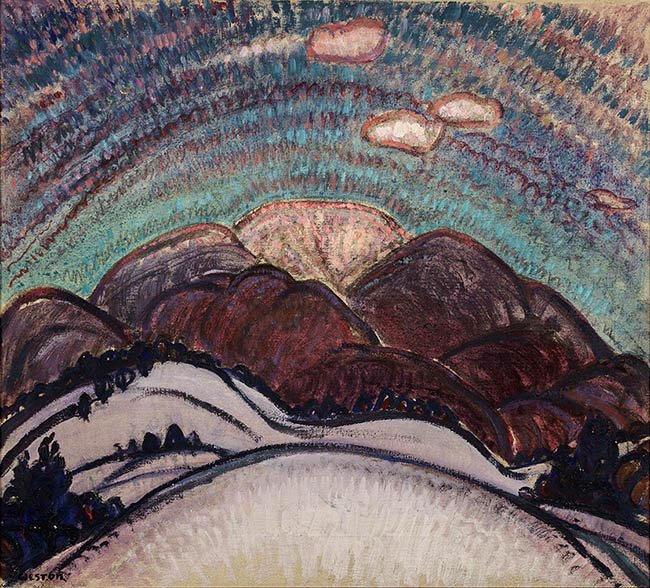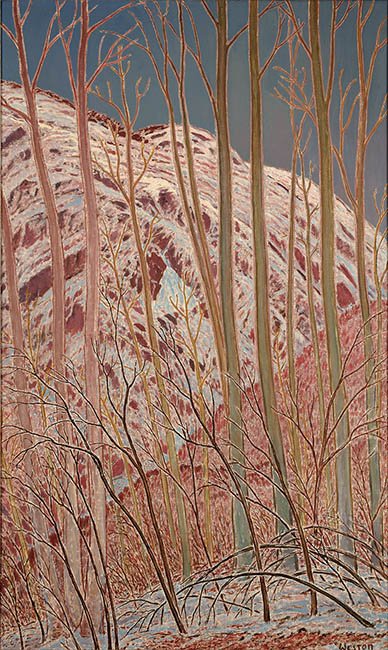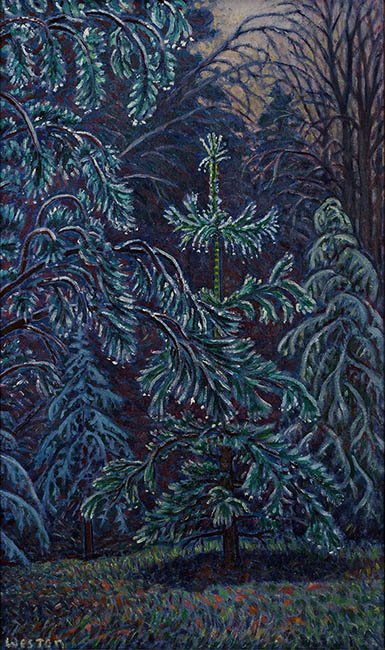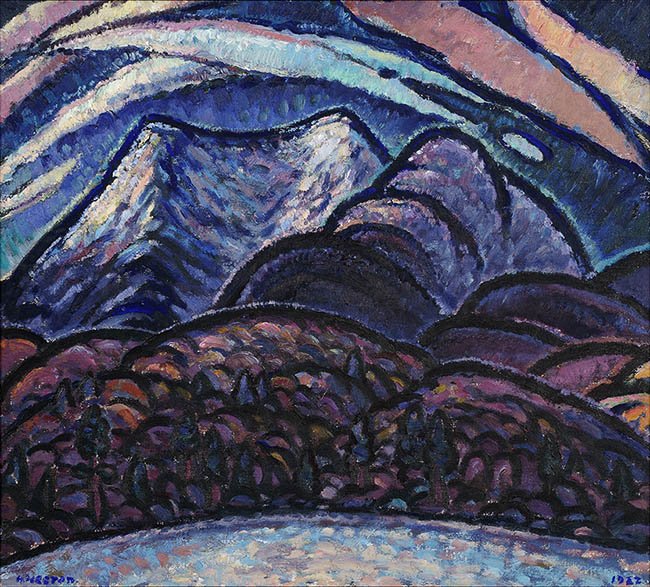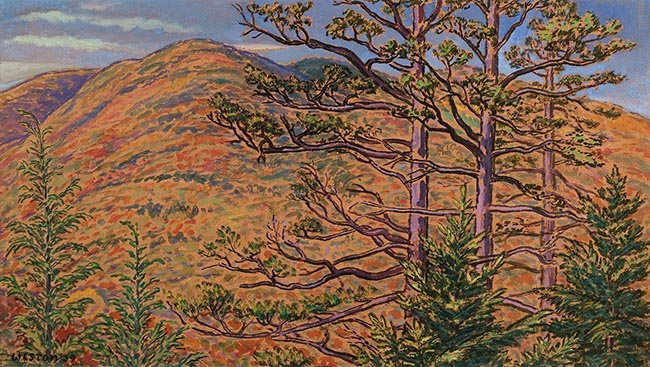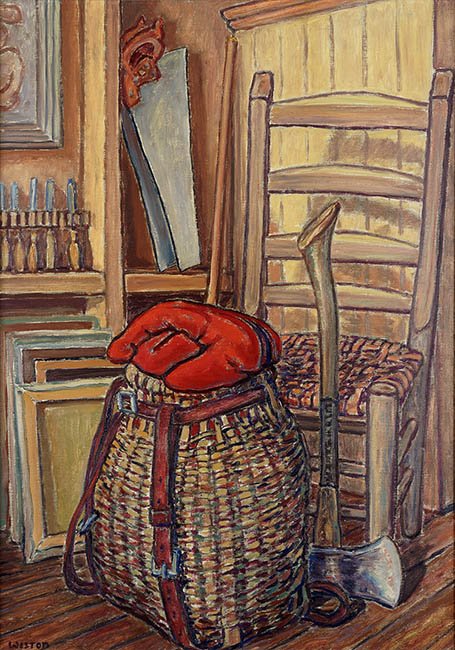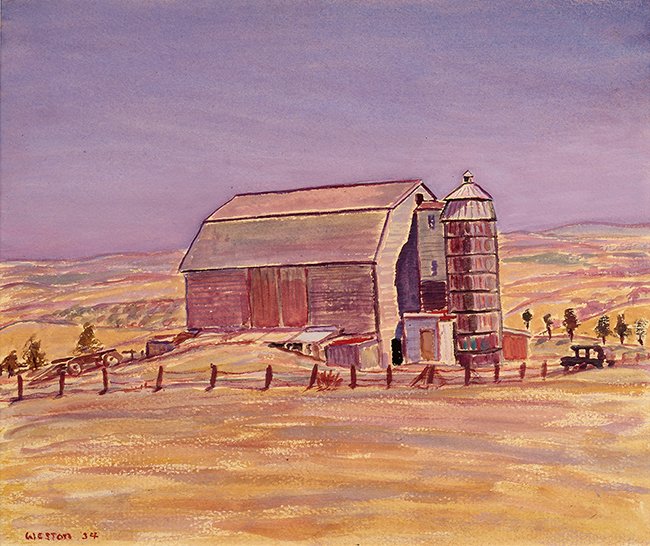Nov 30, 2017- Feb 22, 2018
Essay | Some works may still be available, please contact the gallery at 212-581-1657
Essay by Deedee Wigmore
Harold Weston: Modernist of the Adirondacks is the second exhibition of Weston’s Adirondack landscapes I have done working with the artist’s daughter Nina Foster and granddaughter Rebecca Foster. My husband and I met Harold Weston’s wife Faith around 1975 at an exhibition of the artist’s paintings held at The Adirondack Store and Gallery in Raybrook, New York. We felt an immediate connection to the abstracted beauty of Weston’s spiritual Adirondack landscapes and made some purchases. I have been a member of Harold Weston’s fan club ever since.
Harold Weston (1894-1972), born in Merion, Pennsylvania, graduated from Harvard in 1916 magna cum laude, Phi Beta Kappa, and editor of The Lampoon. During the summers, while at Harvard, Weston took art classes with Hamilton Easter Field (1873-1922) in Ogunquit, Maine. Field provided him with a foundation of design principles and an introduction to Modernism and subjective interpretation. After graduation, Weston spent three and a half years helping with war relief in Persia during World War I then traveled extensively through the Far East.
Back in the United States by 1920, Weston furthered his art studies with William Schumacher (1870-1931), an American Symbolist inspired by the modernism he witnessed in the 1913 Armory Show. While attending art school in New York, Weston realized his calling was to paint directly from nature. He built a studio in St. Huberts, three miles south of Keene Valley in the Adirondacks, where his family had vacationed for two generations. There Weston developed his own style of distinctive patterning, outlined areas of color, and fragmented forms.
Success came quickly to Harold Weston. His first major exhibition opened November 8th, 1922 at The Montross Gallery, a leading New York gallery associated with The New York Ten and their early Modernism. Montross remained Weston’s dealer until 1932 when the owner Newman Montross died. That first exhibition had 62 paintings and 100 sketches, primarily of Adirondack subjects. All the oil paintings had pine frames carved by Weston and the best sketches sold for $200. The exhibition was a huge success. Weston was compared favorably with Marsden Hartley as a modernist who used color as an instrument of emotional expression and of plastic design in his response to a rugged place. His nature forms were described as modernist but not unrecognizable, challenging but not alienating. Weston had six solo exhibition at Montross Gallery between 1922 and 1932. With established success, Weston married Faith Borton of Moorestown, New Jersey in 1923 and the two spent much of their time in the Adirondacks.
Weston began to work in watercolor early in 1923 after the Brooklyn Museum offered to feature his work in their annual exhibition in April if he could produce a group of watercolors as good as his oils. With only a few months until they were due, Weston took on this difficult medium with impressive technique and strong colors. While traveling in Europe in the late 1920s, Weston worked in watercolor on colored paper for added vibrancy and color. Our exhibition includes 6 examples of Weston’s works on paper in watercolor and gouache.
Suffering from poor health, Weston and his wife moved to France from 1926 to 1930. There they traveled between the Pyrenees and Paris, alternating between remote mountains and the influential expatriate society of Gertrude Stein and the Modernist movement. Weston continued to send work to his dealer, Montross Gallery.
Weston returned to America in 1930, beginning a decade in which his career and reputation grew steadily. He received valuable exposure through his friendship with Duncan Phillips, the influential art collector and critic. In 1928 Phillips purchased the first in what would eventually become a collection of 34 works by Weston. During the 1930s alone, the Phillips’ Memorial Gallery in Washington DC (now the Phillips Collection) mounted four solo exhibitions. Another achievement of that decade was the series of murals across 22 panels (840 square feet) Weston painted for the General Services Administration Building in Washington between 1936 and 1938; the mural was a commission awarded by the Treasury Relief Art Project. In 1939 Weston’s vibrant Girl with Green Hat won a prize at the Golden Gate International Exhibition in San Francisco. From 1949 to 1952 Weston created a series of six oils showing the successive stages of the United Nations buildings during its construction, which was purchased by the Smithsonian Institution.
Our exhibition contains 14 paintings executed between 1921-1940 in oil, gouache, and watercolor as Weston was proficient in all of these mediums. Weston packed a knapsack with a tin sketchbox that had paints, pencils, and small pieces of card board, usually nine by six inches. While climbing or canoeing, Weston worked in small sketches when he was struck by a composition to capture the fast moving atmosphere and light found in the Adirondacks. In his first fall sketching in the Adirondacks in 1920, Weston wrote in his diary, "I feel I ought to make studies of two definite sorts, close to nature and freely interpretive." These sketches gave Weston a visual and emotional clue of what he was after when he returned to his studio. Weston also took photographs of subjects that inspired him. In the 1930s traveling by car, Weston recorded in watercolor or gouache sketches the farms, mines, and small towns that interested him. Some of those sketches are a part of our exhibition.
[ TOP ]
Modernism 1913-1950 | Realism of the 1930s and 1940s | Abstraction of the 1930s and 1940s | Post-War | Selected Biographies

